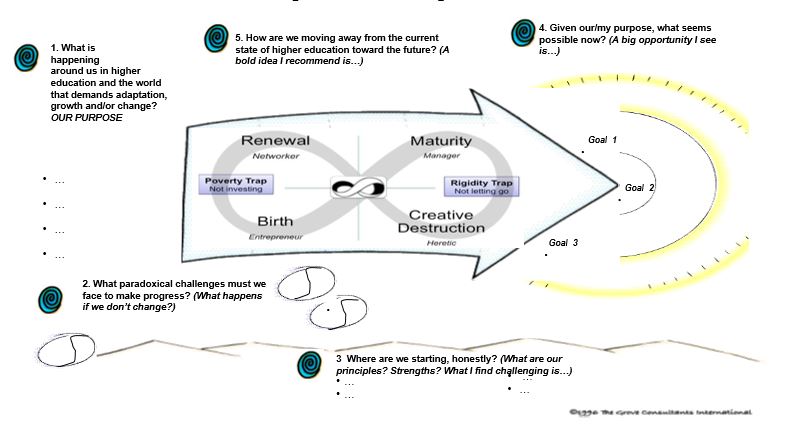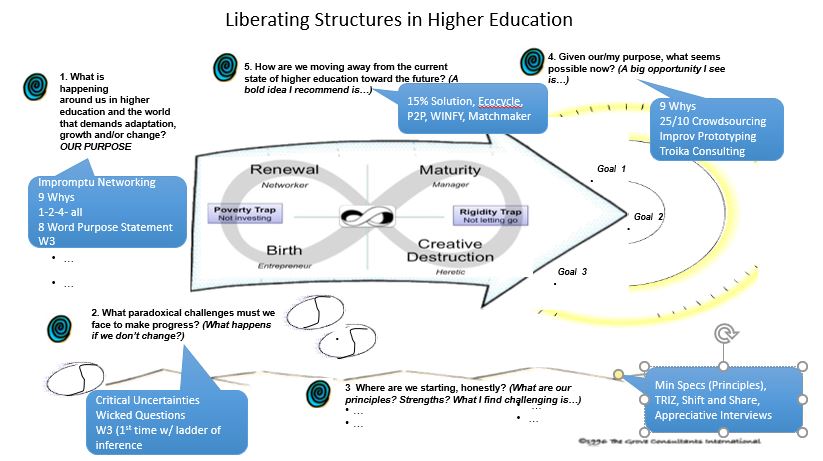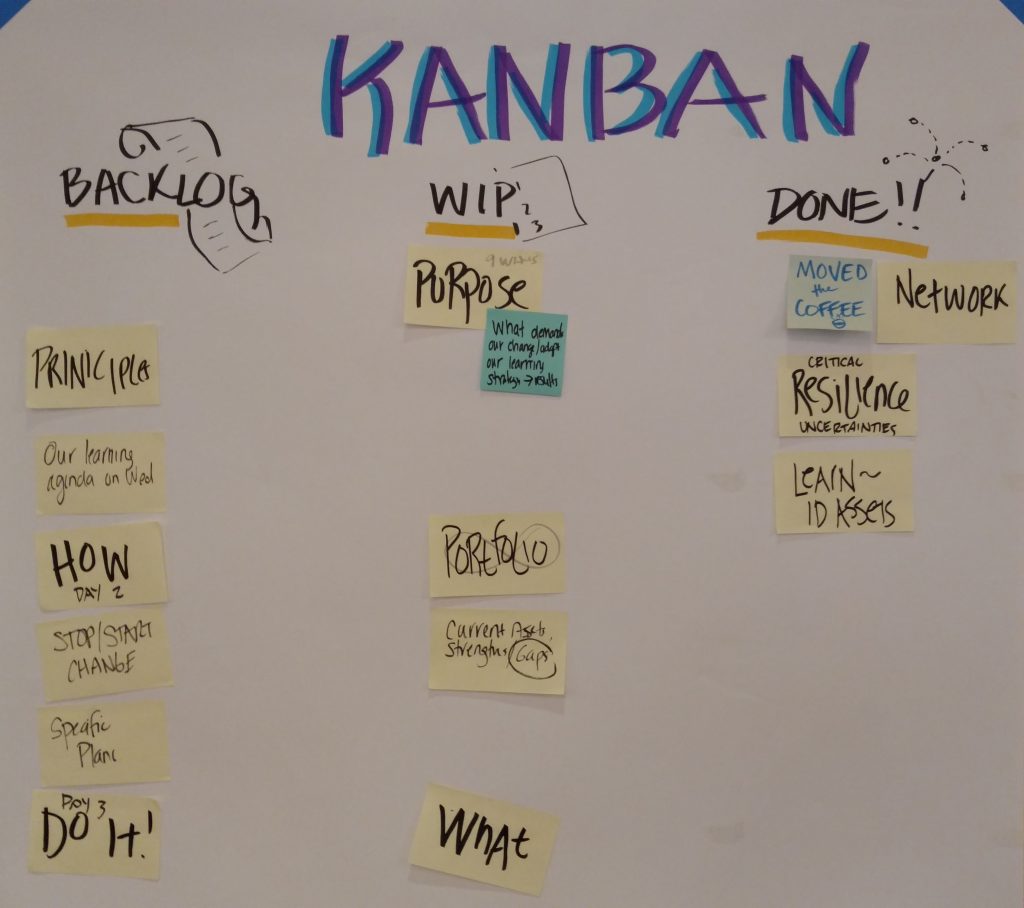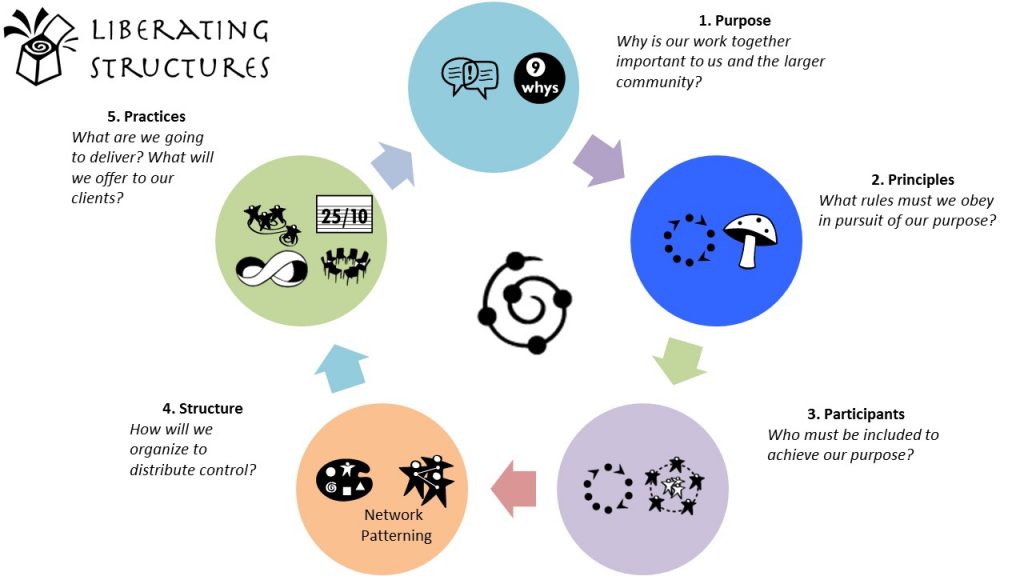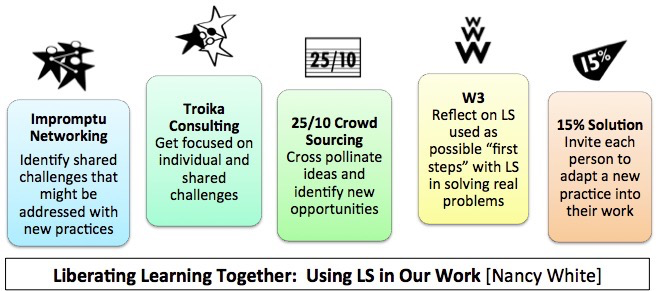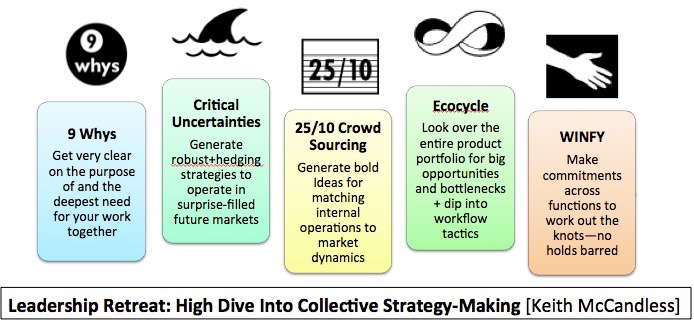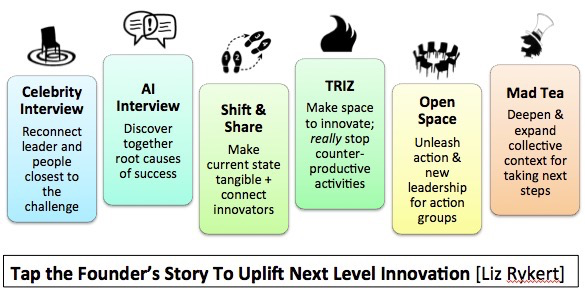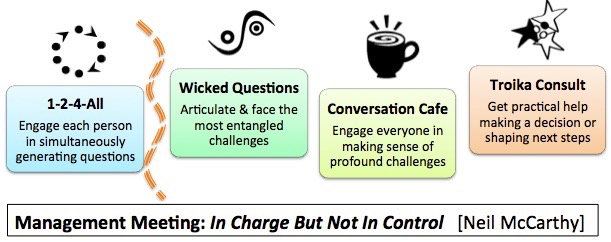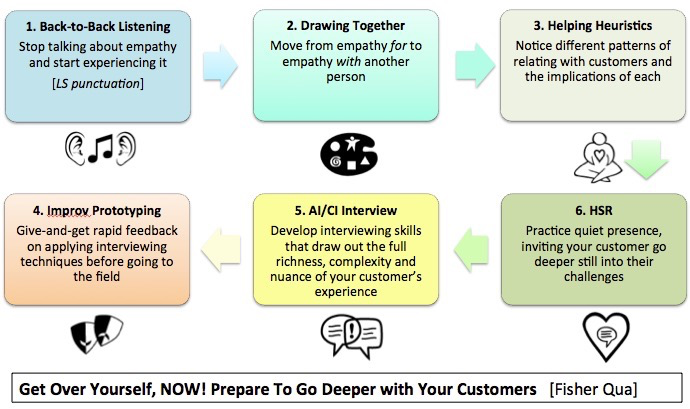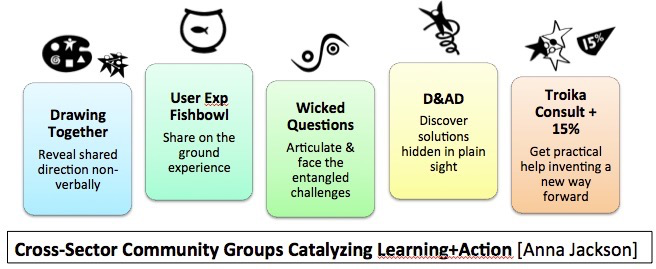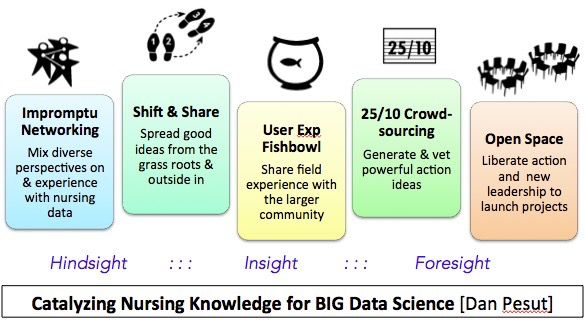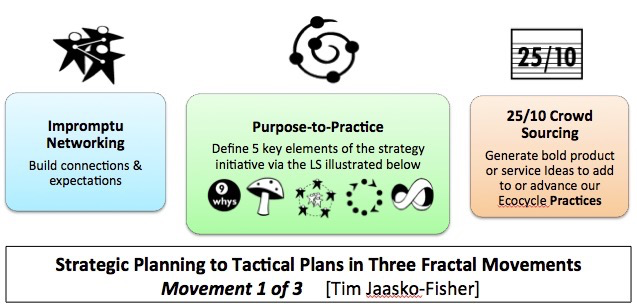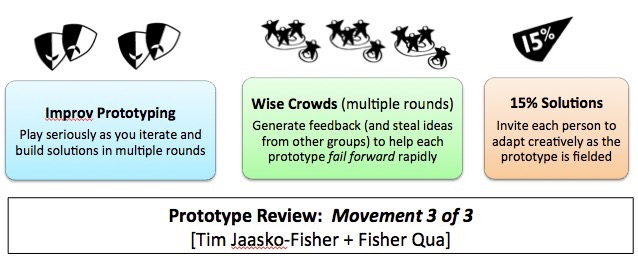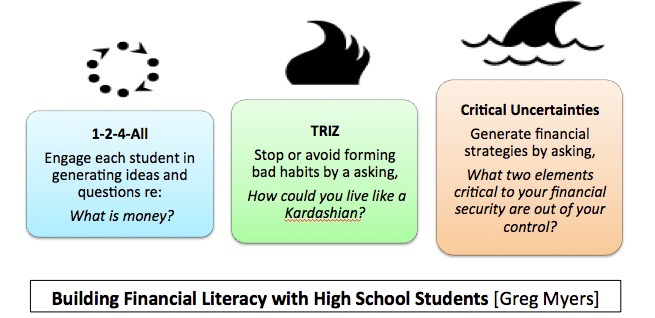This second post will describe the Liberating Structures string used at the Fire Adapted Communities Network three day retreat in Ashland, Oregon earlier this month to demonstrate the application of LS for strategic planning in contexts that are portfolio based, complex and full of (good!) people, all mentioned in part 1 where it all started.
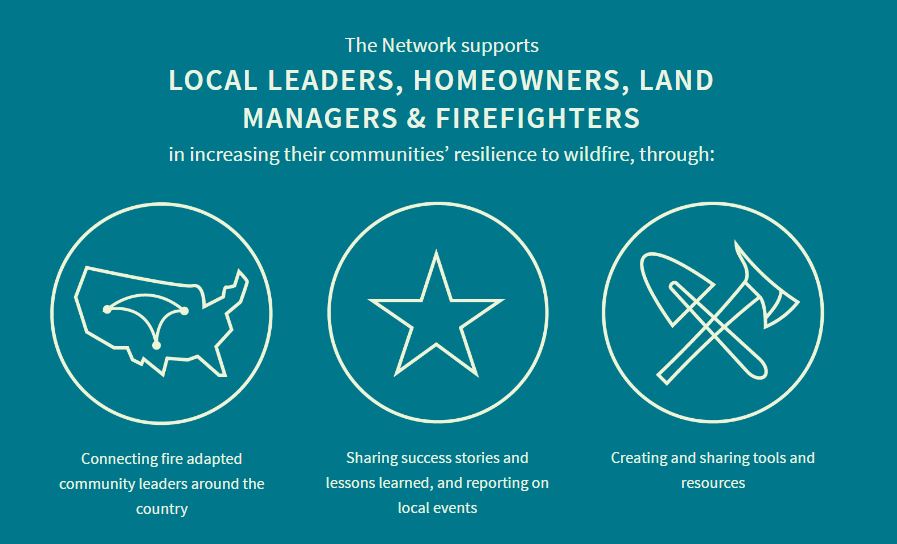 The Fire Adapted Communities Network springs out of work sponsored by The Watershed Research and Training Center and The Nature Conservancy (TNC). The network is dedicated to working with peope helping communities live safely with wildland fire. They have a very clear mission: “We work with communities across the nation to create a more wildfire-resilient future. A “fire adapted community” consists of informed and prepared citizens collaboratively planning and taking action to safely co-exist with wildland fire.”
The Fire Adapted Communities Network springs out of work sponsored by The Watershed Research and Training Center and The Nature Conservancy (TNC). The network is dedicated to working with peope helping communities live safely with wildland fire. They have a very clear mission: “We work with communities across the nation to create a more wildfire-resilient future. A “fire adapted community” consists of informed and prepared citizens collaboratively planning and taking action to safely co-exist with wildland fire.”
A key strategy for the network at it’s birth was to work through communities of practice (CoPs). After a year and a half, it was time to look at the progress so far and develop a learning agenda within and across the CoPs going forward, since the core function of the network is to identify, spread and apply good fire adapted community practices. Learning is always at the core.
I was initially invited in to do an afternoon’s training on CoPs but after a short conversation, I suggested that a CoP approach, woven across their three days, might be more meaningful than training. You know, that stuff which can often go in one ear and out the other. Additionally for me, a CoP perspective is more useful than simply focusing on the form of CoPs themselves. This idea of a CoP perspective is from Etienne Wenger-Trayner and basically asks us to consider the domain – what we are interested in learning and applying learning, the community – who we learn with, and the practice – how we learn and apply our learning. To look at whatever we are doing from that social learning perspective.
As the meeting concept evolved, the team eventually invited me to help them design and facilitate the three days, giving them a chance to step back and participate themselves, and see Liberating Structures in action. I in turn promised to weave in little CoP “meta moments” as issues and opportunities arose.
We proceeded to plan a lovely agenda for an amazing group of enthusiastic, smart and dedicated volunteers and staff. I had my string of Liberating Structures and back ups all designed. I had my adapted visual Strategy Gameplan sketched out. The gameplan is something I learned from Keith McCandless and which I’ve been tinkering with over the past six months. It builds off the foundation of a visual process templates developed by David Sibbet at the Grove, then adding the LS twists and questions. What used to be the “first steps” in the middle of the arrow (traditional first quarter, second quarter planning) has now been replaced by the LS Ecocycle to hold the portfolio and to recognize what is in or ready for scaling, what needs destroying/stopped, what needs to be imagined and birthed. This final twist is what has broken new ground for me. More on that in a minute…
Anchor Questions
I continue to tinker and modify the questions. In an actual application, they are customized to the issues/domains of the people using them, but the generic ones can offer us some insight. What you see above are actually draft questions for a LS Immersion Workshop in February with BC Campus on the use of LS in higher education. (IF this is relevant to you, JOIN US!) If people are interested, we can share our string once we finish it and I hopefully will debrief the event with a blog post afterwards. For the FAC communities, obviously the questions were about FAC!
- What is happening around us that demands change? (Often the words growth, adaptation can come into play.) This question has a long lineage through facilitation and planning practices and I find it particularly energizing to help identify purpose. Keith has said he has stopped wasting time with vision and mission and uses this sort of question to sharpen PURPOSE. I’m heading in the same direction. Then values and principles – really important aspects – are worked on in the context of the purpose, not as stand-alones. See Purpose to Practice for examples of the purpose/principles link.
- What paradoxical challenges must we face to make progress? This to me is the reality check and often the ground shifting conversation in working in a complex environment. It is not “if we do X, Y will happen.” It can be competing priorities, uncertain futures (classic example here in the US with a wild card president-elect!), antagonizing circumstances etc. Dealing with this up front in the context of the sub-question makes it more stark: What happens if we don’t change? In other words, how do we keep moving forward in this land of “wicked questions?” Paradoxes are not things to defeat us, but to change how we view a problem. To shift our mindset. What is not very obvious from my image is that those circles are yin/yang containers for these paradoxes.
- Where are we starting, honestly? This question can have many layers and options, from identification of strengths (things in our “Maturity area” of the Ecocycle) , positive deviance, as well as the challenges, the things we have resisted or feared discussing, the light and the dark. Speaking our truths, sometimes just between ourselves, sometimes “to power.” This question surfaces the things we have to work with. AND the things we need to creatively destroy in the Creative Destruction are of the ecocycle.
- Given our purpose, what big ideas seem possible now? (Remember, question 1 surfaced our purpose. I keep wondering if I should add that label…) What big opportunities do we see? What is ready to be imagined and then stewarded into birth. This frames our shared impetus forward.
- How are we moving away from the current state to our desired future state? This is the practical piece. What are the next steps? Things we can decide and do. Start now. Do something. Don’t wait to plan for perfection. ACT!
Anchor Structures
For each question in the gameplan there are a variety of Liberating Structures we can use. Because this image is small, I’ll also add a list below as a starter point, but one of the heaven/hells of LS is that you have many options to use a structure in different phases and in different ways. That comes after building your overall LS practice! 🙂
- Impromptu Networking to quickly get people talking about real issues. 9 Whys to make sense of initial insights. 1-2-4-all to see diverse viewpoints and synthesize patterns. User Experience Fishbowl to surface perspectives. 8 Word Purpose Statement (which is an LS in development and not well documented on the website yet) to hone down to the most important part of the purpose, to clarify and compel. What, So What, Now what (W3)to move the process to question 2. Often in my first use of W3 I’ll weave in Argyris’s Ladder of Inference as documented on the W3 LS page. This all drives the Ecocycle.
- Critical Uncertainties to move us away from some fixed perception of the context and future and build robust, resilient and anti-fragile possibilities in our work. Wicked Questions to tackle the paradoxical challenges. W3 again to reflect. Sometimes these identify where we are stuck in the rigidity or poverty traps of the Ecocycle.
- Min Specs to identify and sharpen principles, TRIZ to surface the real issues if we are still avoiding or not being able to see them, Shift and Share to spread strengths, Discovery and Action Dialog to identify positive deviants, Appreciative Interviews to surface strengths. Generative Star Relationships or What I Need From You to surface team issues… plus so many other LS! Map on the Ecocycle.
- 25/10 Crowdsourcing to identify big ideas. 9 Whys to sharpen big ideas. Improv Prototyping and Troika Consulting to both develop, test and improve ideas. Put them all on the Ecocycle.
- 15% Solutions to get stuff we can do NOW. Purpose to Practice to develop discrete projects within the portfolio. Plus a ton more LS! The team building LS mentioned in #3 may come into play here as action moves forward. (Edit: see also Social Labs’ piece on prototyping.)
Now of course you aren’t going to do ALL of these. I have been using about 2, sometimes 3 structures per question and I always have alternatives in my “back pocket.” This is my own emerging edge.
Noticing Turning Points
I’ve uses this approach three times now in the past three months and each time there has been a moment in the gathering where all of a sudden we notice a turning point. For the TNC folks it became clear when we could not nail down a clear purpose. The energy up to that point had been on building the people side of the network and its constituent CoPs and the turning point shifted the focus to what strategic learning agenda or agendas would move the network forward. From that some of the CoPs found clarity for their forward movement, some because obsolete and were targeted for sunsetting, and some new needs and forms were identified. The current portfolio was better understood, and then the group could then go through the process of identifying their new and emergent elements of the portfolio. What is scaled to its next level of maturity? The well defined CoPs. What is destroyed? The fuzzy CoPs? What new ideas are imagined? New forms and focus for learning.
Be warned that this is a powerful string for creative destruction. DON’T go there if you are not prepared to have your past assumptions blown away, and your plans may change. DO go there if you are in a complex and uncertain environment, or when you have audacious ambitions that require powerful thinking and doing.
Documentation
The Graphic Game Plan + Ecocycle gives you a place to harvest the most important parts of the process and provide a base documentation for going forward. It has been nearly impossible for me to include the fully developed Ecocycle in the game plan (unless you have a ginormous wall) so I have the full Ecocycle on a separate page and just harvest out the key ideas and turning points. I also use a Kanban chart to track the LS as we go through them, and our tasks as we go through. There are three columns: Backlog (what is to be done), WIP (work in progress and make sure you keep this LIMITED. Thank you Jim Benson) and Done! (track and CELEBRATE!). My Kanbans are very dynamic, and role model how we adapt as things emerge. Here is a picture of a Kanban from the FAC gathering:
What, So What, Now What?
Walking my own talk, what I have observed in the use of this approach is:
- people get confused. Uncomfortable. And playful. And engaged.
- issues are made visible
- it can get messy
- I did not always lead/invite/explain well
So What, or why I think this is important is because the approach:
- is flexible and adaptable
- people quickly see and own it (visually, emotionally and cognitively)
- making confusion visible is a useful thing
- it provides a container for surfacing and using discomfort and diversity
- IT REALLY HELPS US find some solace in the complexity that might otherwise overwhelm us
- it takes practice and I still have my sticking points
Now What?
- I’d like to improve the harvest and graphic container for the harvest.
- Keep practicing
- Get YOUR feedback. That’s what the comments are for, ok?
Edit: For a great read on planning in a complex world, see Chris Corrigan’s post.
